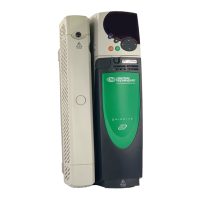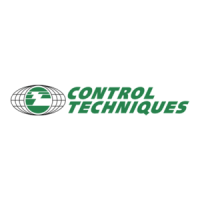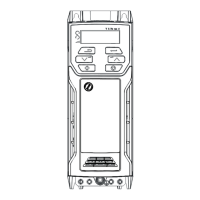Parameter
structure
Keypad and
display
Parameter
x.00
Parameter
description format
Advanced parameter
descriptions
Macros
Serial comms
protocol
Electronic
nameplate
Performance
Feature look-
up table
Menu 3
All modes
Unidrive SP Advanced User Guide 67
Issue Number: 7 www.controltechniques.com
If the position feedback device is SC.Hiper or SC.EnDat it is possible for the drive to set up this parameter automatically from information obtained
from the encoder (see Pr 3.41).
EnDat, SSI - Comms only encoder mode
If this parameter is set to 1 or 2 the drive always takes the complete absolute position for these comms only type encoders. The turns (Pr 3.28),
position (Pr 3.29) and fine position (Pr 3.30) will be an exact representation of the position from the encoder. If the encoder does not provide 16bits of
turns information, the internal representation of the turns used by the position controller in Menu 13 and functions within the SM-Applications Module
such as the Advanced Position Controller, rolls over at the maximum position value from the encoder. This jump in position is likely to cause unwanted
effects. As the SSI format does not include any error checking it is not possible for the drive to detect if the position data has been corrupted. The
benefit of using the absolute position directly from an SSI encoder is that even if the encoder communications are disturbed by noise and position
errors occur, the position will always recover the correct position after the disturbance has ceased. The EnDat format includes a CRC that is used by
the drive to detect corrupted data, and so if the position data has been corrupted the drive uses the previous correct data until new uncorrupted data
is received.
If this parameter is set to 0 the drive only takes the absolute position directly from the encoder during initialisation. The change of position over each
sample is then used to determine the current position. This method always gives 16 bits of turns information that can be used without jumps in
position by the position controller in Menu13 and SM-applications modules etc. This method will only operate correctly if the change of position over
any 250µs period is less than 0.5 of a turn, or else the turns information will be incorrect. The turns can then only be corrected by re-initialising the
encoder. Under normal operating conditions and at a maximum speed of 40,000rpm the maximum change of position is less than 0.5 turns, however,
if noise corrupts the data from an SSI encoder it is possible to have apparent large change of position, and this can result in the turns information
becoming and remaining corrupted until the encoder is re-initialised. This problem should not occur with EnDat encoders because three consecutive
corrupted messages at the slowest sample rate (i.e. 25µs) would be required even at the maximum speed of 40,000rpm before the change of position
would be the required 0.5 turns to give possible corruption of the turns information. If three consecutive messages with CRC errors occur this will
cause the drive to produce an Enc5 trip. The drive can only be re-enabled after the trip is reset which will re-initialise the encoder and correct the
absolute turns.
If an SSI encoder is used, but is not powered from the drive, and the encoder is powered up after the drive, it is possible that the first change of
position detected could be large enough to cause the problem described above. This can be avoided if the encoder interface is initialised via Pr 3.47
after the encoder has powered up. If the encoder includes a bit that indicates the status of the power supply the power supply monitor should be
enabled (see Pr 3.40). This will ensure that the drive remains tripped until the encoder is powered up and the action of resetting the trip will reinitialise
the encoder interface.
Trips can be enabled/disabled using Pr 3.40 as follows.
Encoder trips
The following table shows trips that can be initiated that are related to the drive encoder feedback and whether they can be enabled and disabled by
Pr 3.40.
3.40
Drive encoder error detection level
Drive modes Open-loop, Closed-loop vector, Servo
Coding
Bit SP FI DE Txt VM DP ND RA NC NV PT US RW BU PS
111
Range Open-loop, Closed-loop vector, Servo 0 to 7
Default
Open-loop
Closed-loop vector, Servo
0
1
Update rate Background read
Bit Function
0 Wire break detect
1 Phase error detect
2 SSI power supply bit monitor
Encoders Reason for error Drive trip
All Power supply short circuit Enc1
Ab, Fd, Fr, Ab.Servo, Fd.Servo,
Fr.Servo,
SC, SC.Hiper, SC.EnDat, SC.SSI
+Hardware wire-break detect on A, B and Z inputs
(1)
Software wire break detection on sine wave signals
Enc2
Ab.Servo, Fd.Servo, Fr.Servo
SC.Hiper, SC.EnDat, SC.SSI
+Phase error
(2)
+Sine/cosine phase error
(3)
Enc3
SC.Hiper, SC.EnDat, SC.SSI
EnDat
SSI
Comms failure (timeout)
(5)
Comms failure (timeout) or transfer time too long
Comms transfer time is too long
Enc4
SC.Hiper, SC.EnDat, EnDat
Checksum/CRC error or SSI not ready at start of position
transfer (i.e. data input not one)
Enc5
SC.Hiper, SC.EnDat, EnDat
SSI, SC.SSI
The encoder has indicated an error
+Power supply failure
Enc6
http://nicontrols.com

